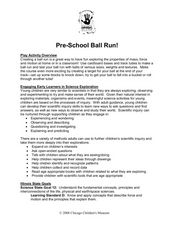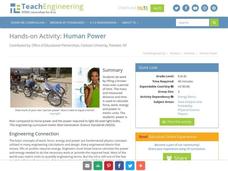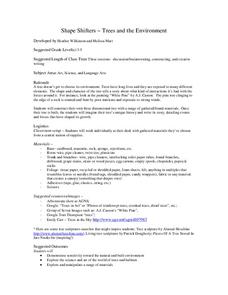Curated OER
Paper Clip Walk
Fifth graders investigate the behavior of magnetism using magnets. They discuss magnetic force, and conduct an experiment, testing how many paper plates can be stacked together before the force of the magnetic field no longer affects a...
Curated OER
Physics on the Playground
Students investigate friction on a playground slide. In this force and energy lesson, students will predict, plan, and implement a scientific investigation to the problem; What materials will allow me to slide the fastest down a slide?
Curated OER
Balloonautics
Young scholars are introduced to basic aerodynamics through a discussion of thrust and drag and a hands-on activity. They examine the forces of thrust, drag, air pressure, aerodynamic shapes and Newton's Third Law Of Motion.
Curated OER
Pre-School Ball Run
Students demonstrate force and motion by rolling a ball through a tube. In this motion lesson students explore what happens to the ball when it is rolled with other balls of various sizes, weights, and textures.
Curated OER
Causal Patterns in Air Pressure Phenomena Section 2
Students compare models depicting air pressure, They determine which model best conveys the omnidirectional and passive nature of air pressure
Curated OER
Tsunamis
Learners investigate the natural disasters known as tsunamis by researching the Internet. In this nature lesson, students define the word tsunami and discuss how they are created. Learners complete an online activity based on water...
STEM for Teachers
Tsunami!
How does the depth of an ocean affect the speed of a tsunami's waves? Use Jell-o, graham crackers, and marshmallows to model the effects of an underwater earthquake and its resulting tsunami. The lesson includes hands-on activities,...
Curated OER
Who Wants to be a Millionaire? Solar System
Fifteen questions about our solar system make up this interactive review game. It was written by a teacher in the UK, and therefore the monetary winnings for answering correctly are in pounds. The content applies, however, to any...
Curated OER
How Wind Works
Second graders investigate the process that creates wind. In this wind lesson, 2nd graders create a wind diagram. Students write an essay to accompany their diagram.
Curated OER
Gravity Versus the Mighty Egg
Students design, revise and construct a method for protecting an egg from cracking when it is dropped from a height. They work in small groups to develop their protection method and then collect and analyze data as a class when each...
Curated OER
Natural Disasters
Ninth graders write a description of a natural disaster. They list as many natural disasters as they can think of. The class discusses any natural disasters individuals have witnessed first hand. They watch a brief clip of a film that...
Curated OER
Early Colonial Labor Force: Indentured Servants and Slaves
Students study the labor force used during Colonial America. In this Colonial America lesson, students discuss labor types used in the colonies. Students read about indentured servants and the use of African slaves. Students use the...
Curated OER
The Energy Task Force
Students simulate a meeting of the President's energy task force in order to observe how energy policy may be developed with the input of various groups. Students will form groups with the following roles: lobbyists, members of the...
Curated OER
Motions and Forces
Sixth graders investigate the construction of a magnet and the force it produces. They identify various materials as magnetic or non-magnetic, discuss the properties of magnetic properties, and conduct an experiment with a compass and...
Curated OER
How Evolution Works
Students examine the term natural selection and what behavioral adaptations are. In this evolution lesson students view videos about evolution and perform experiments that simulate populations that interplay between the forces of...
Curated OER
Nature Reflections
Middle schoolers have a greater appreciation for the nature around them. They participate in a series of reflection exercises. Students encounter blindfolds, and bandannas with cardboards as bases.
NASA
Gravitational Waves
Young scientists participate in a hands-on experiment to explore Einstein's theory of relativity in a creative manner. They investigate various waves and compare their characteristics as they discuss how each wave is created. Next,...
Teach Engineering
Human Power
How many humans does it take to power a light bulb? The 10th part of a 25-lesson Energy Systems and Solutions unit has learners conduct an experiment to calculate power. They then use the results to determine how many classmates they...
Teach Engineering
Stop the Stretching
Stretch your teaching repertoire with an experiment on the elongation (stretching) and failure (break) of several materials. The point of the experiment is to design a composite material for chair webbing.
Curated OER
Pump It Up
Students use water in a flask to simulate how oil is pumped or forced out of the Earth by pressure from natural gas or human machinery. In this oil lesson plan, students complete a lab packet and work in groups.
Curated OER
Design Your Own Rube Goldberg Machine
Students participate in a culminating activity for a unit on Energy and Simple Machines. They are challenged to incorporate simple machines in to a complex mechanical system. While designing and testing their machine they will also...
Curated OER
Shape Shifters- Trees and the Environment
Students make a tree sculpture. In this trees and the environment lesson, students learn about the parts of a tree, discuss what a tree needs in order to grow, find images of trees in art and nature, use various materials to create a...
Curated OER
Permeability (Magnetism)
High schoolers investigate magnetic permeability and saturation. For this physics lesson, students explain how current carrying wire coils create magnetic forces. They interpret normal magnetization curves.
Curated OER
Fabrics and Polymers
Students explore natural resources by reading a science story in class. In this fibers lesson, students identify and discuss the differences between fibers such as wool, silk, rayon, linen and cotton. Students identify the common uses of...

























